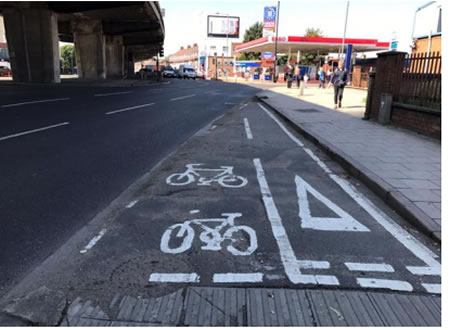A4 Stretch Of Brentford Is 'Most Striking Example Of A Hostile Street'
Pollution and fast traffic make it a place for cars, not people, says report

A stretch of the A4 in Brentford has been described as "the most striking example of a hostile street" in a recently released report by the London Assembly Transport Committee.
In her summary to the report, Caroline Russell, (Green Party LA member) wrote 'The most striking example of a hostile street we saw was near Brentford, where primary schools are straddled by the A4 and M4 flyover. We walked the route with parents and children, who showed us how difficult it was for them to get to school.

Caroline Russell
"They were worried about fast-moving traffic, high levels of pollution, and getting stuck in the middle of the busy road waiting for ages for a green light to cross.'
The report said that the area "feels like a place for cars, not for people." It noted that the speed limit along the A4 at Brentford was 40mph where children were crossing to get to school.
It also noted that the cycle lane on the A4 directs bikes into three lanes of oncoming traffic -see picture below

The Transport
Committee holds the Mayor and Transport for London to account for their
work delivering the capital's transport network. The committee examines
all aspects of the transport network and presses for improvements on behalf
of Londoners.
Whilst preparing the report the committee members visited various streets
in Outer London, including Walthamstow, Croydon, Havering and Bow as well
as the A4 in Brentford.
They found that 'busy junctions in outer London can feel like hostile places, dangerous to people travelling on foot or by bike'
Hounslow Green Party has been calling for improvements on the Brentford stretch of the A4 for over two years. Victoria George, Brentford Green Party's representative, says, 'We are pleased that the London Assembly are taking notice. Being home to one of outer London's least people-friendly streets is not something to be proud of. We need our council to put pressure on TFL to improve this dangerous and polluted road sooner rather than later.'
The reports
states: "As London grows, more people are living alongside main roads
and busy
junctions. It is increasingly important that these places work for people
walking and cycling. If the Mayor is to achieve his aim that all Londoners
should walk or cycle 20 minutes a day, he will have to address the challenges
facing these growing communities."
The report recommends changing the culture at TfL to stop prioritising motor traffic including reviewing speed limits on all roads to see if 20mph may be relevant, because fast moving traffic is much more dangerous to cyclists and pedestrians than slow moving traffic.
The Mayor has said that he will prioritise walking, cycling and public transport when making decisions about London's streets. This is part of his Healthy Streets approach, launched in February 2017, which looks to improve London's health by designing physical activity back into everyday lives.
The GLA Conservatives did acknowledge that some of the recommendations were useful but argued that the report had exceeded its remit to understand the experience of cyclists and pedestrians using busy junctions, and to consider how TfL and London boroughs can use junction works to unlock walking and cycling potential.
They criticised the report's suggestion that the speed limit be 20 mph on certain junctions, arguing that this would not help keep traffic moving on what were busy arterial routes.
You can read the full report, which also has a lot of information about cycling and cycle lanes in other areas of London, which might be of interest locally due to the CS9.
December 14, 2017